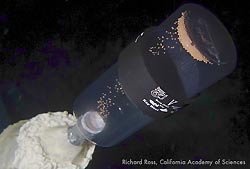From and written by Animal World
October 5, 2013 by clarice

The Octo Mom pales in comparison to the Florida Keys Coral Spawn
An event that happens just once a year yet results in hundreds of thousands of babies. Imagine have just one such happening to produce all the offspring you could ever want! That’s the annual spawning of Elkhorn, Staghorn and other corals off the Florida Keys.
For just a short period of time each year, by a phase of the moon, thirty thousand coral colonies or more are synced-up and driven to reproduce. This happens in August or September, usually just a few days after a full moon.
Now that type of baby making is enough to stir the envy of any mom, Octo or otherwise! Granted, there’s not the same type of physical interaction mammals have, making babies in the animal world. There’s no dating or marriage, nor ongoing obligations.
Coral parents never actually have sex, nor do the mothers (or fathers) then host and provide sustenance for the developing offspring. Rather corals are sessile invertebrates that spew their gametes (eggs and sperm) into the ocean’s water column in one mass spawning exchange.
Buoyant gamete bundles float about the water column until they meet up with gametes from neighboring colonies. Cross-fertilization, resulting is baby corals, is then a happen stance event.

Coral Spawning, Gamete Bundles
Hundreds of thousands of fertilized gametes quickly evolve into coral planula, which soon becomes free-swimming larvae. A few days later they will begin making their way down to the reef. They will seek a suitable area to on the reef area to settle, attach and form polyps.
These polyps grow into beautiful new coral colonies, expanding the reef.
Coral spawning is a curious event similar to being in an upside down snowstorm. Tons of tiny little flakes begin swirling about. But corals only spawn at night, so to watch this wondrous “dance of the gametes”, it helps to be a scuba diver. It also helps to be experienced in diving at night so that you don’t miss any of this exciting event. This years spawning lasted for 4 consecutive days.

Restoration of Corals in the Florida Keys
The Coral Restoration Foundation (CRF), based in the Florida Keys, has been working to restore various threatened coral species. I had an opportunity to see some of their cultured specimens of staghorn corals just a few weeks ago at the SuperZoo trade show. Ken Nedimyer, president of the foundation, was very excited about their ongoing efforts in creating offshore coral nurseries, as well as an onshore lab for studying reproduction.
For this years spawning event, CRF joined with 8 other organizations from across the country. Representatives from Akron Zoo, California Academy of Science, Florida Aquarium, Mystic Seaquarium, NOAA, Seaworld and Disney Worldwide Conservation Fund joined with CRF to provide help and support. 25 people in all worked to collect spawn from the open waters as well as from selected staghorn specimens spawning in their lab.

You and I, and everyone are invited to volunteer and participate in CRF dive programs to help plant specimens. Although the spawning season has passed until the fall of 2014, the restoration efforts are ongoing. The ultimate goal of CRF is to test the fertilization of selective gametes in an effort to propagate more resistant corals and help ensure their survival.
Clarice Brough is a team member at Animal-World and has contributed many articles and write-ups.
